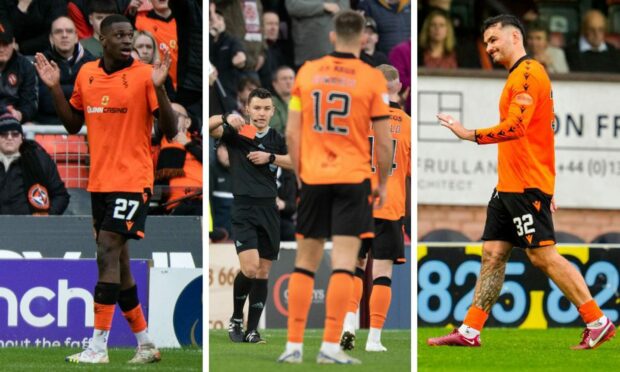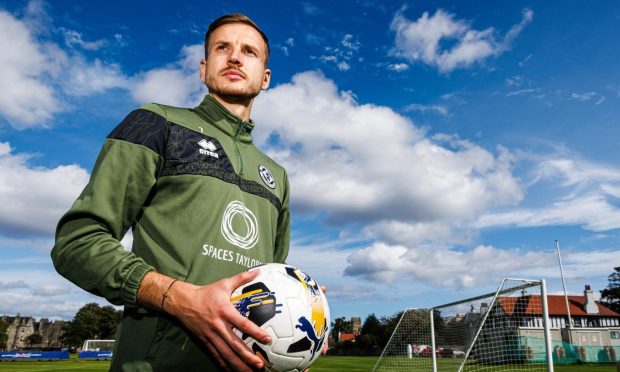Dundee United are leading the charge for a summit on VAR.
The Tangerines have been stung by a series of controversial calls this season.
The latest came in Saturday’s draw with St Mirren, when Loick Ayina was penalised for what looked a very soft challenge on the Paisley side’s Curtis Main.
Saints equalised from the resultant spot kick, leaving drop-battling United without a league win since January 2.
Now the Tangerines are demanding high level talks between all Premiership clubs, the game’s governing bodies and Scottish referees, aimed at finding a solution to mounting VAR chaos.
Every club has been involved in video dramas this season.
And here are five of United’s most contentious VAR moments.
Loick Ayina vs St Mirren
With less than 20 minutes remaining of Saturday’s clash with St Mirren, United were 1-0 up and focused on securing a much-needed Premiership victory.
Referee Craig Napier’s decision to point to the penalty spot after visiting striker Main, shepherded by Ayina, hit the deck in the box infuriated those in tangerine.
When VAR Colin Steven ratified the on-field decision after several minutes – without asking Napier to take a second look – and St Mirren equalised from the spot to earn a share of the spoils, the sense of injustice at Tannadice was palpable.
United boss Jim Goodwin was booked for his protests in the aftermath.
And questions abound for club and fans alike about the process followed.
Ryan Edwards vs Hearts
United were at the tail end of one of their most impressive opening half-hours of the season when VAR became a talking point at Tynecastle in early February.
A Steven Fletcher strike had the Tangerines a goal to the good and motoring towards half time when Ryan Edwards swept forward to clear a loose ball off the toe of Hearts’ Andy Halliday.
He did so with purpose – but not enough to trigger a foul in the eyes of referee Nick Walsh.
However, that “no foul” was upgraded to a straight red card after video official Chris Graham, feeling Walsh to have made a clear and obvious error, urged him to look again.
Ten-man United held onto their lead until former hero Lawrence Shankland notched the equaliser on 71 mins.
Further strikes by Alex Cochrane and Stephen Humphrys made it another painful afternoon for the Tangerines.
United’s subsequent decision to appeal – which was denied despite being backed by the recipient of the challenge – stands as a clear indication of their concerns around the implementation and use of VAR on the day.
Connor Goldson vs Rangers
United started well against Rangers at Tannadice in January and, with the score at 0-0 in the first half, felt they had a strong penalty shout when the ball struck Connor Goldson’s arm from a corner.
Referee Steven MacLean was uninterested and VAR did not recommend a second look.
It was the second consecutive week Gers star Goldson had been involved in a handball controversy involving VAR.
But, as in the previous game against Celtic, neither the official on the pitch nor the one in Scottish football’s VAR suite intervened.
In the aftermath, then-United boss Liam Fox called for clarity around the use of VAR in handball incidents.
Two months later, clubs – including United – are still at a loss as to how and why VAR is used in various scenarios.
Steven Fletcher vs Hearts
With the Tangerines 2-1 ahead against Hearts on Christmas Eve, a long ball over the top from Mark Birighitti drew opposite number Craig Gordon into a head-to-head foot race with Fletcher inside the Jambos’ box.
Assessing what happened when the players collided is impossible without acknowledging the outcome – a devastating injury for a popular and hugely respected player in Gordon.
Those on the pitch – including officials – would have to be superhuman to have remained unaffected.
But in the immediate aftermath of the collision, before the extent of Gordon’s injury became apparent, referee Colin Steven pointed to the spot to award United a penalty.
After being asked to look again amid the resulting chaos, Steven reversed his decision and awarded Hearts a free kick.
On this occasion, the subjective nature of the VARs intervention is likely to have concerned United.
The sudden and violent nature of the players’ collision makes a call either way seem entirely dependent on the interpretation of the individual watching.
Was it a penalty to Dundee United or a free kick to Hearts? Was it either? Take your pick.
Interpretation will always be part of refereeing.
But was this a case of VAR encroaching beyond black and white issues into a far greyer area?
Tony Watt vs Motherwell
United were 1-0 down to Motherwell at the end of October when VAR David Munro reached out to referee John Beaton.
The on-field whistler, having initially seen nothing wrong with then-Tangerines striker Tony Watt’s attempt to close down Sean Goss, was urged to look again at the call.
Having done so, Beaton upgraded his initial decision – no foul – to a straight red card, having deemed Watt’s actions “serious foul play”.
Ten-man United lost the game, with pundits later playing down the seriousness of the incident and the SFA downgrading the straight red card to a caution.











Conversation